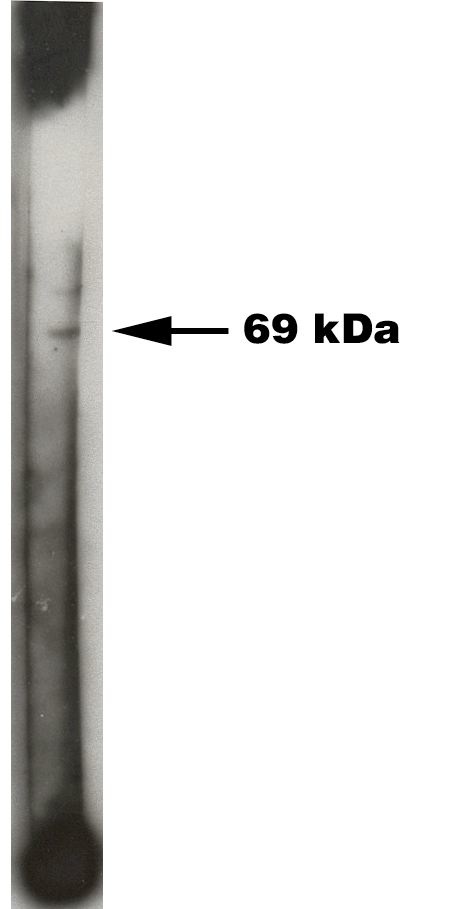Catalogue

Rabbit anti Human Sphingosine Kinase 2
Catalog number: X1628P| Isotype | IgG |
| Product Type |
Antigen Immunoaffinity Purified Polyclonal |
| Units | 100 µg |
| Host | Rabbit |
| Species Reactivity |
Human Mouse Rat |
| Application |
ELISA Western Blotting |
Background
Sphingosine Kinase 2 (Sphk2) catalyzes the phosphorylation of sphingosine to sphingosine 1-phosphate (S1P), an important signaling molecule with intra- and extracellular functions. Inside the cell S1P acts as a signaling molecule like other sphingolipid metabolites like ceramide and sphingosine. S1P has been implicated in regulating cell differentiation, calcium mobilization from intracellular stores, and apoptosis. The cell surface receptors for S1P are the EDG family of G protein-coupled receptors (S1P Receptors). These receptors couple to multiple G proteins (e.g. S1P1 couples to Gi whereas S1P2 and S1P3 couple to Gq, G13 in addition to Gi) and regulate a extremely wide range of cellular events including cell motility, survival, apoptosis, migration and cell-cell interaction. Important roles for S1P have also been reported in regulation of cardiogenesis, vascular maturation, oocyte survival, immune cell trafficking, cells of the neuronal system and bone cells. S1P levels are regulated by the activity of Sphk (Sphk1 and Sphk2).
Synonyms: EC 2.7.1, SK 2, SPK 2, SPHK2, Gene name: SPHK2 or SPHK or SP
Source
Rabbits were immunized with a synthetic peptide derived from the N-terminal region of Sphingosine Kinase 2
Product
Provided as solution in phosphate buffered saline with 0.08% sodium azide
Product Form: Unconjugated
Purification Method: Antigen Immunoaffiinity Purification
Concentration: Lot specific, see vial label
Applications
Antibody can be used for Western blotting (1:50-1:200 dilution) and ELISA. Other applications not yet tested. Optimal concentration should be evaluated by serial dilutions.
Functional Analysis: Western Blotting
Positive Control: Active Recombinant Sphingosine Kinase Enzyme (Cat. No. X1709E)
Storage
Product should be stored at -20°C. Aliquot to avoid freeze/thaw cycles
Product Stability: See expiration date on vial
Shipping Conditions: Ship at ambient temperature, freeze upon arrival
Caution
This product is intended FOR RESEARCH USE ONLY, and FOR TESTS IN VITRO, not for use in diagnostic or therapeutic procedures involving humans or animals. It may contain hazardous ingredients. Please refer to the Safety Data Sheets (SDS) for additional information and proper handling procedures. Dispose product remainders according to local regulations.This datasheet is as accurate as reasonably achievable, but Nordic-MUbio accepts no liability for any inaccuracies or omissions in this information.
References
1. Kihara A, Ikeda M, Kariya Y, Lee EY, Lee YM, Igarashi Y, Sphingosine-1-phosphate lyase is involved in the differentiation of F9 embryonal carcinoma cells to primitive endoderm. J. Biol. Chem. 278 (2003) 14578-14585
2. Choi OH, Kim JH, Kinet JP, Calcium mobilization via sphingosine kinase in signalling by the FceRI antigen receptor. Nature 380 (1996) 634-636
3. Olivera A, Kohama T, Edsall L, Nava V, Cuvillier O, Poulton S, Spiegel S, Sphingosine kinase expression increases intracellular sphingosine-1-phosphate and promotes cell growth and survival. J. Cell Biol. 147 (1999) 545-558
4. Chun J, Goetzl EJ, Hla T, Igarashi Y, Lynch KR, Moolenaar W, Pyne S, Tigyi G, International union of pharacology. XXXIV. Lysophospholipid receptor nomenclature. Pharmacol. Rev. 54 (2002) 265-269
5. Hla T, Signaling and biological actions of sphingosine 1-phosphate. Pharmacol. Res. 47 (2003) 401-407
6. Gregorius K, Mouritsen S, Elsner HI, Hydrocoating: a new method for coupling biomolecules to solid phases. J. Immunol. Methods, 181 (1995) 65-73
7. Zhang JH, Chung TDY, Oldenburg KR, A simple statistical parameter for use in evaluation and validation of high throughput screening assays. J. Biomol. Screening, 4 (1999) 67-73
8. Hong Liu, Masako Sugiura, Victor E. Nava, Lisa C. Edsall, Keita Kono, Samantha Poulton, Sheldon Milstien, Takafumi Kohama, and Sarah Spiegel. Molecular Cloning and Functional Characterization of a Novel Mammalian Sphingosine Kinase Type 2 Isoform. J. Biol. Chem., Vol. 275, Issue 26, 19513-19520, June 30, 2000
Product Specific References:
1. Weigert, A., et al. 'Cleavage of sphinosine kinase 2 by caspase-1 provokes its release from apoptotic cells.' Blood, 2010, 115, 3531-3540.
2. Weigert, A., et al. 'Apoptotic cells promote macrophage survival by releasing the antiapoptotic mediator sphingosine-1-phosphate.' Blood, 2006, 108, 1635-1642.
Protein Reference(s)
Database Name: UniProt
Accession Number: AF245447
Species Accession: Human
Safety Datasheet(s) for this product:
| NM_Sodium Azide |

" Western blot analysis using Sphingosine Kinase 2 antibody on 50 ng of recombinant Sphinogsine Kinase 2 enzyme (Cat. No. X1709E). Antibody used at 1:200 dilution. Visualized using Pierce West Femto substrate system. Secondary used at 1:30k dilution. Exposure for 45 seconds."

